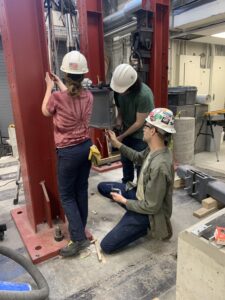Beyond the Books
Whether dynamic class projects, research endeavors, fieldwork, or community initiatives, the emphasis is on learning by doing. This active learning not only fosters students’ critical analysis and synthesis, it helps spark their intellectual curiosity, discover their passions, and fuel their ambitions. Here are just two examples.
Students in Walter A. Scott Chair of Integrative Engineering David Brandes’ Environment and Energy Systems Engineering class are involved in an exciting project with Arvoredos Island off the coast of Brazil. This fully sustainable site was developed by Lafayette alumnus Fernando Lee Class of 1924 in the 1950s as a demonstration site for sustainable water, energy, and food systems. The infrastructure at the site is in need of refurbishing and students will be working with the INMAR Foundation, which oversees the island, to develop preliminary design plans for system upgrades focusing on the rainwater collection and treatment system in particular. With support from [Education Beyond the Classroom endowment], the class will travel to Ilha do Arvoredo during spring break to gather information and collaborate more directly with INMAR staff.
Working with Assistant Professor of Civil & Environmental Engineering David Mante in the Lafayette College Concrete Laboratory (LCCL), students ZoeOhl ’25 ( pictured), Sean Walshe ’25 (pictured), and Omar Soto ’24 are conducting full-scale laboratory testing on bridge joints for concrete bridge decks for PennDOT. Mechanical Engineering Professor Jeff Helm is assisting with the instrumentation of the test article, including measurement of the deflection of the bridge joint using digital image correlation. Highway bridges need strong decks to carry cars and trucks. Usually, these decks wear out after 20 to 30 years, and they either get replaced using traditional cast-in-place construction or with pre-made concrete panels. For prefabricated concrete deck panels to be viable, connections between deck panels must remain simple and efficient, but also emulate the structural behavior of a traditional cast-in-place bridge deck. The ultimate goal of the team’s project is to propose enhancements to the existing PennDOT precast deck panel joints. The joint simplification will significantly reduce the cost of bridge deck replacement projects within the Commonwealth, as well as reduce the downtime the traveling public experiences during bridge deck replacement projects.
pictured), Sean Walshe ’25 (pictured), and Omar Soto ’24 are conducting full-scale laboratory testing on bridge joints for concrete bridge decks for PennDOT. Mechanical Engineering Professor Jeff Helm is assisting with the instrumentation of the test article, including measurement of the deflection of the bridge joint using digital image correlation. Highway bridges need strong decks to carry cars and trucks. Usually, these decks wear out after 20 to 30 years, and they either get replaced using traditional cast-in-place construction or with pre-made concrete panels. For prefabricated concrete deck panels to be viable, connections between deck panels must remain simple and efficient, but also emulate the structural behavior of a traditional cast-in-place bridge deck. The ultimate goal of the team’s project is to propose enhancements to the existing PennDOT precast deck panel joints. The joint simplification will significantly reduce the cost of bridge deck replacement projects within the Commonwealth, as well as reduce the downtime the traveling public experiences during bridge deck replacement projects.
These and other exciting opportunities for students are made possible through generous support from alumni and friends of Lafayette Engineering.